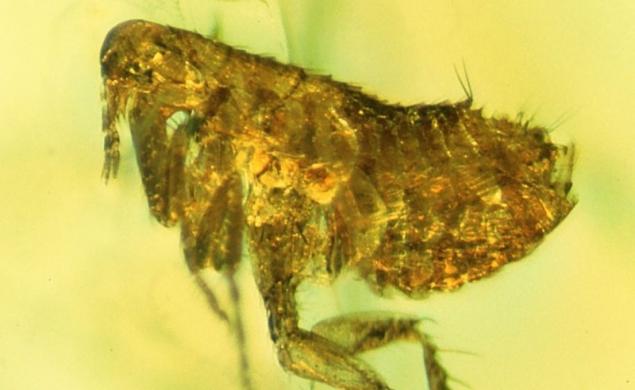430
The flea from a piece of amber 20 million years found plague Bacillus
Plague was a real disaster for the people many hundreds of years. Due to the plague died out entire cities. The origin of Yersinia pestis to track is quite difficult, but I guess now scientists have managed to shed some light on this dark area. So, in a piece of amber 20 million years discovered a flea, which, in turn, found the causative agent of bubonic plague.
According to the scientist who made the discovery, the plague Bacillus from amber, not only similar to their descendants, but is in the same part of the body of the flea, and the modern plague. Plus, the scientists were able to detect the microorganism in a drop of blood on the proboscis of an insect. The researchers who made this discovery believe that 20 million years ago the plague was transmitted in much the same way as now. The study is published in the Journal of Medical Entomology.

The discovery made by scientists is not accidental — it is this team of researchers, led by George Poyner (George Poinar) from the University of Oregon, hunting ancestors of the modern microorganisms for many years. The best object to study in the case of catalogul is amber. Recently, scientists have managed to discover an ancient fungus belonging to the ergot, and lived at a time when the Land roamed by dinosaurs and flowered for the first flowering plants.

As for the piece of amber with flea, its Dating is a pretty complicated question. Now there are two versions regarding the time of formation of this amber: this can be either a time period 45-30 million years ago, or the period 20-15 million years ago.
Upon detection of fleas, the scientists subjected her to a detailed study, with the result that managed to find spots of blood on the proboscis of the insect, the front legs, plus a strange structure in the gut of fleas. Under the microscope it turned out that these structures — aggregations of microbes that are very similar in appearance to the causative agent of bubonic plague. If this is true, that the plague is not a few thousand years, but millions or even tens of millions.
The final conclusion in this respect can only be done after the flea is extracted from amber, and analyze both the insect and the microorganisms from the gut of fleas. According to the experts who made the discovery, is still the plague Bacillus, as all characteristics and features the "colony" microorganisms in the gut of the flea is indirectly confirmed.
The modern plague Bacillus, rastrogavshis in the body of the flea, takes place not only in the intestine, but in the "craw" fleas. This prevents the normal flow of blood from the body of the victim in the stomach of the insect and flea plague throws a stick of goiter in the body of the victim. After that, the stick begins to proliferate actively in the new media.published
P. S. And remember, only by changing their consumption — together we change the world! ©
Join us in Facebook , Vkontakte, Odnoklassniki
Source: geektimes.ru/post/263190/
According to the scientist who made the discovery, the plague Bacillus from amber, not only similar to their descendants, but is in the same part of the body of the flea, and the modern plague. Plus, the scientists were able to detect the microorganism in a drop of blood on the proboscis of an insect. The researchers who made this discovery believe that 20 million years ago the plague was transmitted in much the same way as now. The study is published in the Journal of Medical Entomology.

The discovery made by scientists is not accidental — it is this team of researchers, led by George Poyner (George Poinar) from the University of Oregon, hunting ancestors of the modern microorganisms for many years. The best object to study in the case of catalogul is amber. Recently, scientists have managed to discover an ancient fungus belonging to the ergot, and lived at a time when the Land roamed by dinosaurs and flowered for the first flowering plants.

As for the piece of amber with flea, its Dating is a pretty complicated question. Now there are two versions regarding the time of formation of this amber: this can be either a time period 45-30 million years ago, or the period 20-15 million years ago.
Upon detection of fleas, the scientists subjected her to a detailed study, with the result that managed to find spots of blood on the proboscis of the insect, the front legs, plus a strange structure in the gut of fleas. Under the microscope it turned out that these structures — aggregations of microbes that are very similar in appearance to the causative agent of bubonic plague. If this is true, that the plague is not a few thousand years, but millions or even tens of millions.
The final conclusion in this respect can only be done after the flea is extracted from amber, and analyze both the insect and the microorganisms from the gut of fleas. According to the experts who made the discovery, is still the plague Bacillus, as all characteristics and features the "colony" microorganisms in the gut of the flea is indirectly confirmed.
The modern plague Bacillus, rastrogavshis in the body of the flea, takes place not only in the intestine, but in the "craw" fleas. This prevents the normal flow of blood from the body of the victim in the stomach of the insect and flea plague throws a stick of goiter in the body of the victim. After that, the stick begins to proliferate actively in the new media.published
P. S. And remember, only by changing their consumption — together we change the world! ©
Join us in Facebook , Vkontakte, Odnoklassniki
Source: geektimes.ru/post/263190/























